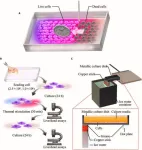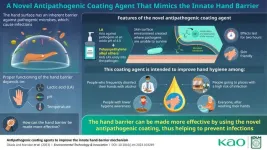(Press-News.org) Hyperthermia is a potentially non-invasive cancer treatment that capitalizes on the heat intolerance of cancer cells, which are more sensitive than normal cells. In order to induce effective hyperthermia, it is necessary to apply the appropriate temperature according to the cell type, i.e., to comprehensively study the thermal toxicity of the cells, which requires accurate regulation of the culture temperature. Researchers from Keio University in Japan have developed a cell culture system with temperature gradients on a metallic culture surface that can be used to study the optimal conditions for effective hyperthermia. Their new training scheme is described in a paper published in the journal of Cyborg and Bionic Systems on August 7.
Although surgery, chemotherapy and radiation are the major approaches for cancer treatment, each strategy has side effects and aggressiveness. Hyperthermia is considered as a potential cancer treatment due to its minimal side effects and invasiveness. Hyperthermia involves exposing the diseased area to a dose of thermal stimulation thereby selectively killing cancer cells where thermal cytotoxicity is more prominent. However, regulating the temperature of the cell incubator cannot immediately and accurately apply a thermal stimulus to the cells because the temperature of the cell exposure site is indirectly regulated by the mosphere in the incubator.
In order to accurately control the temperature of cell exposure, the researchers fabricated a culture system based on a metallic culture vessel and a Peltier element. Because of the metallic culture surface, temperature stimulation of the cells can be immediately and accurately controlled, and the system can be manipulated to produce a range of temperature gradations, which helps to simultaneously evaluate cellular responses to a variety of temperature stimuli.
Pure titanium culture vessels fabricated by metallic 3D printing were subjected to extensive temperature gradients triggered by iced water and hot plates. The thermal conductivity of metal is higher than that of polystyrene, and the system allows instant temperature regulation compared to traditional plastic containers. Michigan Cancer Foundation-7 (MCF-7) and normal human dermal fibroblasts (NHDF) were used as model cancer cells and normal cell types, respectively, and the difference in temperature tolerance between the two types of cells was confirmed by determining the area of live and dead cells.
At high cell densities, only the temperature tolerance of NHDF was enhanced, whereas that of MCF-7 was not affected, which is consistent with previous reports.
The results obtained by this system are only guaranteed to be qualitatively similar but quantitatively different. First, since only the nuclei of dead cells are stained, the threshold temperature is not directly indicative of the lethal temperature. Secondly, the surface environment of the petri dish may introduce mechanical stimuli to the cells and affect their thermal response. Finally, cells exposed to different culture temperatures create a chemically stimulated new culture environment by secreting hormones.
Systems that exhibit temperature gradients provide new research directions for future cancer hyperthermia. Using the perfusion culture system to eliminate chemical stimuli as well as impeding cell proliferation to obtain a clearer live/dead cell boundary is a research direction for more accurate evaluation of this system. In addition, the present system can be used for other purposes to assess the thermal response of cells.
END
Titanium culture vessel presenting temperature gradation for the thermotolerance estimation of cells
2023-09-07
ELSE PRESS RELEASES FROM THIS DATE:
1 in 2 patients had better blood pressure control after using remote, bilingual program
2023-09-07
Research Highlights:
More than half of adults (55%) with uncontrolled blood pressure who enrolled in a digital monitoring program that connected patients with clinical advice and included a bilingual app paired with at-home blood pressure monitors had controlled final blood pressure measurements after participating for least 90 days.
Patients using the Spanish-language version of the digital monitoring program demonstrated more improvement in blood pressure control than patients who used the English-language version.
Embargoed until 6:30a.m. CT/7:30 a.m. ET Thursday, Sept. 7, 2023
BOSTON, Sept. 7, 2023 — Over half of patients ...
High blood pressure while lying down linked to higher risk of heart health complications
2023-09-07
Research Highlights:
An analysis of data from a long-running study of more than 11,000 adults from four diverse communities in the United States has found that adults who had high blood pressure while both seated upright and lying supine (flat on their backs) had a higher risk of heart disease, stroke, heart failure or premature death compared to adults without high blood pressure while upright and supine.
Adults who had high blood pressure while lying supine but not while seated upright had similar elevated risks of heart attack, stroke, ...
Cold weather may pose challenges to treating high blood pressure
2023-09-07
Research Highlights:
An analysis of electronic health records for more than 60,000 adults in the United States found that systolic, or top-number, blood pressure rose slightly during the winter compared to summer months. The health records were of adults being treated for high blood pressure from 2018 to 2023 at six health care centers of varying sizes located in the southeast and midwestern United States.
The researchers found that, on average, participants’ systolic blood pressure increased by up to 1.7 mm Hg in the winter months compared to the summer months.
They also found that population ...
Community-based, self-measured blood pressure control programs helped at-risk patients
2023-09-07
Research Highlights:
Community health centers participating in the National Hypertension Control Initiative (NHCI) that introduced self-measured blood pressure interventions to their patients — including individuals from Black, Hispanic and American Indian/Alaskan Native populations, who are disproportionately impacted by hypertension and by the COVID-19 pandemic — experienced improvements in blood pressure control rates since 2021, when NHCI began.
Community Health Centers in the NHCI that received funding from the U.S. Department of Health and Human Service’s Health Resources and Services Administration and Office of Minority Health and ...
Amsterdam UMC study finds elite athletes safely return to top-level sports after COVID-19: no issues found in more than 2 years of follow-up
2023-09-07
Heart problems after a COVID infection are a serious concern for both elite athletes and recreational athletes alike. A study from Amsterdam UMC, published today in Heart, offers some reassuring news. "We examined over 250 elite athletes and found that those who had contracted COVID-19 did not experience severe heart issues that impacted their careers," says Juliette van Hattum, a PhD candidate in sports cardiology at Amsterdam UMC.
The study specifically focused on elite athletes, a group that could be particularly susceptible to heart issues, particularly heart ...
Stability inspection for West Antarctica shows: marine ice sheet is not destabilized yet, but possibly on a path to tipping
2023-09-07
Antarctica’s vast ice masses seem far away, yet they store enough water to raise global sea levels by several meters. A team of experts from European research institutes has now provided the first systematic stability inspection of the ice sheet’s current state. Their diagnosis: While they found no indication of irreversible, self-reinforcing retreat of the ice sheet in West Antarctica yet, global warming to date could already be enough to trigger the slow but certain loss of ice over the next hundreds to thousands ...
Early findings suggest clinical and lab-based approach critical to tracking head and neck cancer recurrence
2023-09-07
Early findings of two studies from the University of Michigan Rogel Cancer Center shed light on new ways to anticipate recurrence in HPV-positive head and neck cancer sooner. The papers, published in Cancer and Oral Oncology, offer clinical and technological perspectives on how to measure if recurrence is happening earlier than current blood tests allow, and provide a framework for a new, more sensitive blood test that could help in this monitoring.
“When metastatic head and neck cancer returns, it impacts their quality of life and can be disfiguring, interfering with the ability to talk, ...
Many people have biased perceptions of EDI leaders
2023-09-07
For the past decade, companies across North America have paid more attention to supporting equity, diversity and inclusion (EDI). This has prompted many organizations to create a leadership role fully dedicated to advancing EDI — so much so that between 2015 and 2020, the job title “head of diversity” increased 107 percent on LinkedIn. By 2021, more than half of S&P 500 firms had named a chief diversity officer.
But a new study from the UBC Sauder School of Business shows many people have deeply held beliefs about who should ...
Novel formulation boosts antimicrobial properties of the natural hand barrier
2023-09-07
Contact infection is among the most common ways pathogens, such as bacteria and viruses, spread from one person to another. Hand washing and disinfection are important hygiene practices to minimize the probability of catching infectious diseases. Interestingly, our hands also have a natural barrier that fights off pathogens. While this had been known to science for quite some time, the exact mechanisms by which this barrier acts on pathogens remained a mystery until recently.
In a 2021 study published in Scientific Reports, researchers from Kao Corporation, Japan, revealed that lactic acid (LA), which has a molecular ...
US Department of Defense backs Cosimo Commisso’s pancreatic cancer research
2023-09-07
Cosimo Commisso, Ph.D., has received a grant from the Department of Defense for $1 million to advance the research of a small molecule that kills pancreatic cancer cells by disrupting their pH equilibrium. The project is funded as part of the Pancreatic Cancer Research Program (PCARP), which aims to improve our understanding of pancreatic cancer for the benefit of service members, veterans, their families and the general public.
“We’ve seen that this small molecule—called IMD-0354—works on cancer cells in the lab,” says Commisso, associate professor and director of the Cancer Metabolism and Microenvironment Program at Sanford Burnham Prebys. “This ...


